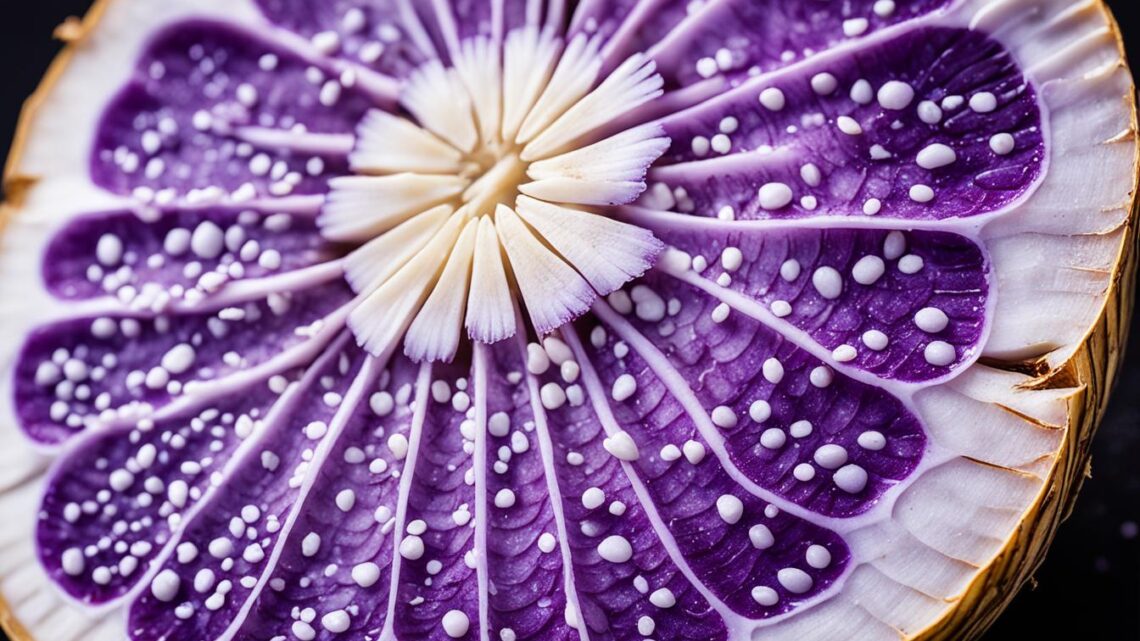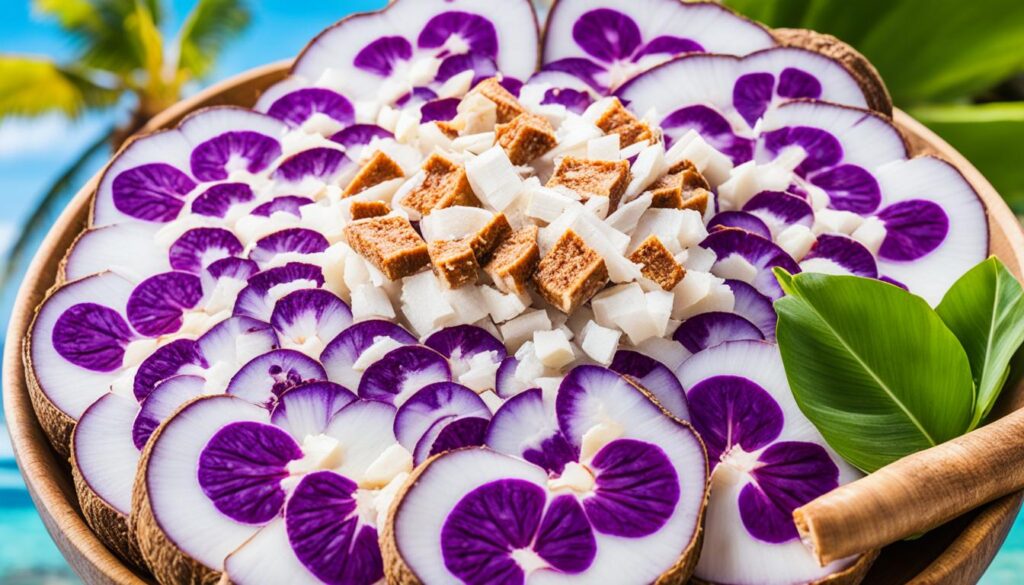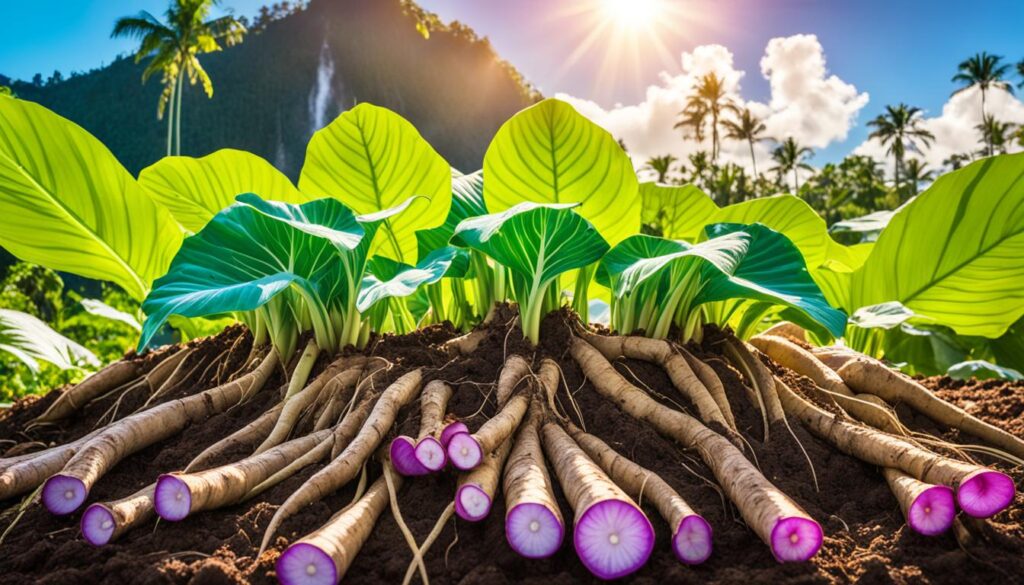
Have you ever heard of the humble yet mighty taro root? It’s a starchy tropical tuber full of nutrients. But what makes it so special for your health? Let’s explore the secrets of this versatile root vegetable loved by food lovers around the world.
What is Taro?
Origins and Cultivation
Taro (Colocasia esculenta) is a starchy tropical root vegetable. It comes from Southeast Asia or India. It belongs to a group of plants with edible stems called corms.
Taro loves to grow near rivers and in fresh water in the tropics. It has big, green leaves like elephant ears and long stems with a bulb at the end. This bulb grows mostly under the ground.
Taro is one of the oldest foods humans have grown. People started growing it around 5000 B.C.E. It spread all over the world through people moving, climate changes, and sharing knowledge.
| Taro Cultivation Facts | Statistics |
|---|---|
| World Taro Production | Around 18 million tons per year |
| Major Taro Producer | Nigeria |
| Taro Cultivation History | One of the earliest cultivated crops, dating back to 5000 B.C.E. |
| Taro Cultivation Regions | Tropical and subtropical regions of South Asia, East Asia, Southeast Asia, Papua New Guinea, northern Australia, and the Maldives |
Taro is one of the oldest foods people grow. It’s not a root but a corm, an underground stem. In different places, it’s called gabi, natong/apay, ede, or kókò/lámbó.

Nutritional Profile of Taro
Taro is a tropical root vegetable full of essential nutrients. It’s a nutritional powerhouse. One cup (132 grams) of cooked taro has 187 calories, mostly from taro’s carbohydrate content. It has less than one gram each of protein and fat. But, taro is great for vitamins, minerals, and dietary fiber.
Some of the key nutrients in taro include:
- Fiber: Taro gives you 6.7 grams of fiber, which is 15% of what you need daily.
- Manganese: It has 30% of the daily manganese you need.
- Vitamin B6: Taro gives you 22% of the daily vitamin B6 you need.
- Vitamin E: It’s a good source, giving you 19% of the daily vitamin E you need.
- Potassium: Taro has 18% of the daily potassium you need.
- Copper: It offers 13% of the daily copper you need.
- Vitamin C: Taro gives you 11% of the daily vitamin C you need.
- Phosphorus: It contains 10% of the daily phosphorus you need.
- Magnesium: Taro gives you 10% of the daily magnesium you need.
Taro root is a nutrient-dense vegetable. It adds valuable vitamins, minerals, and fiber to your diet.

Health Benefits of Taro
Taro is a starchy root vegetable that’s not just tasty but also super healthy. It can help control blood sugar and may fight cancer. This makes it a great food to add to your meals.
May Help Control Blood Sugar
Taro is full of fiber and resistant starch. These help keep blood sugar levels steady. They slow down how fast carbs are digested, preventing big spikes in blood sugar after eating.
Studies show eating foods high in fiber like taro can lower blood sugar in people with type 2 diabetes.
May Reduce Your Risk of Heart Disease
Taro also helps with heart health. Its fiber and resistant starch can lower cholesterol and reduce heart disease risk. The fiber in taro binds to cholesterol and helps remove it from the body.
May Offer Anticancer Properties
Taro is packed with polyphenols, including quercetin, a strong antioxidant. These can help fight cancer and protect against oxidative stress. While more research is needed, eating taro could have anticancer benefits.
Using taro’s fiber, resistant starch, and antioxidants can boost your health. Adding taro to your meals can help prevent chronic diseases like diabetes, heart disease, and cancer.

Taro Around the World
Taro is a tropical root vegetable loved worldwide. It started in Polynesia and now is a key ingredient in many dishes. This versatile crop has become a staple in many places.
In Polynesia, taro is called kalo and is very important. It’s central to the Native Hawaiian creation story. People often boil, mash, and serve it with pork or fish.
In the Pacific region, taro is a main food. It’s used in traditional dishes and stews.
In Asia, taro is also popular. In India, it’s known as Arvi or Arbi. People use it in curries and other dishes. In Nepal, they boil it and season it with salt, spices, and chillies.
In China, taro is used in many ways. It’s braised with meats, made into dumplings, cakes, and desserts.
In the Caribbean, taro is called dasheen. It’s a key part of the national dish callaloo, a stew with taro leaves. In South America, similar roots like malanga and eddoe are used like taro in cooking.
In Africa, taro is also important in cooking. Nigeria produces the most taro, making up about 32% of the world’s supply. Cameroon and Ghana also grow taro. They use the corms and leaves in stews, curries, and soups.
Taro’s versatility and cultural importance make it a favorite in many cuisines. It shows the richness and diversity of food traditions worldwide.
Incorporating Taro into Your Diet
Cooking and Preparation Tips
Taro root is great for both sweet and savory dishes. It’s a good choice instead of potatoes because of its mild sweetness and starchy texture. You can bake, fry, or mash it to bring out its best flavors.
First, peel and prepare taro to remove irritating compounds. Raw taro has calcium oxalate that can sting your mouth. Cook it well by boiling, baking, or pan-frying to make it safe to eat.
Taro is versatile after cooking. You can make crispy taro chips by slicing and baking or frying it. Or, mash it into poi, a traditional Hawaiian dish. Blend it into smoothies or boba tea for a special touch. Add it to pastries or soups for a hearty meal.
| Cooking Method | Preparation Tips |
|---|---|
| Boiling | Peel and cut taro into 1-inch cubes. Boil until tender, about 15-20 minutes. |
| Baking | Peel and slice taro into 1/4-inch thick rounds. Toss with oil, salt, and seasonings. Bake at 400°F for 20-25 minutes. |
| Pan-Frying | Peel and slice taro into 1/4-inch thick slices. Heat oil in a skillet and fry until golden brown, about 2-3 minutes per side. |
These easy tips will help you use taro in many tasty ways. You can make your meals more interesting and healthy with this versatile root vegetable.
Versatile Taro Recipes
Taro is also known as dasheen, eddo, and kalo. It’s a versatile root vegetable. You can enjoy it in many sweet and savory dishes. It’s great for snacks, side dishes, or unique desserts.
Taro has a smooth texture and a mild sweet taste. You can make taro chips, Hawaiian poi, taro tea, and taro buns. It’s also great in soups, stews, and even ice cream. Taro is popular in many cuisines like Chinese, Taiwanese, Hawaiian, Japanese, Vietnamese, and Indian.
For a cozy treat, try making Taro Pudding in your Instant Pot. This recipe makes about 6 cups of creamy pudding. It’s perfect for sharing. Plus, it only takes 33 minutes to cook, including prep and natural pressure release.



